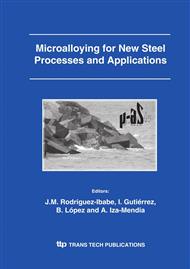p.639
p.647
p.655
p.663
p.669
p.677
p.687
p.695
p.703
Characterisation of Niobium Carbide and Carbonitride Evolution within Ferrite: Contribution of Transmission Electron Microscopy and Advanced Associated Techniques
Abstract:
Niobium is a strong carbide forming element which is often used in microalloyed steels to control the grain size during thermomechanical treatments and to provide strengthening through precipitation processes. A detailed microscopic investigation is one of the keys for understanding the first stages of the precipitation sequence, thus Transmission Electron Microscopy (TEM) is required. The main difficulty of TEM studies is due to the nanometre scale dimensions of the particles, which makes their detection, structural and chemical characterization delicate. Model Fe- (Nb0.06%,C0.05%) and Fe-(Nb0.05%,C0.03%,N0.03%) ferritic alloys subjected to isothermal annealing treatments have been investigated. High Resolution TEM (HRTEM) and conventional TEM (CTEM) were used to characterise the morphology, nature and location of precipitates. Volume fraction measurements and a statistical approach to the determination of precipitate size histograms have been investigated using Energy Filtered TEM (EFTEM) and High Angle Annular Dark Field (HAADF) imaging. Chemical compositions were quantified by Electron Energy Loss Spectroscopy (EELS). The evolution of precipitate composition with time and temperature is compared with previous simulations obtained from new thermodynamic models based on equilibrium boundary conditions.
Info:
Periodical:
Pages:
669-676
Citation:
Online since:
November 2005
Authors:
Price:
Сopyright:
© 2005 Trans Tech Publications Ltd. All Rights Reserved
Share:
Citation:


